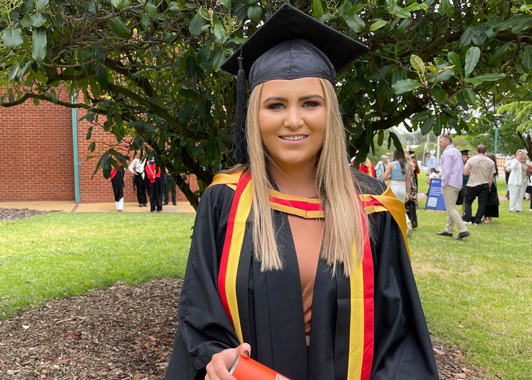29 Nov 2023
News
X-ray vision: a radiographer's superpower

Maddison Cowan
Radiographer, Lumus Imaging, Orange
Bachelor of Medical Radiation Science
Charles Sturt University
Graduated in 2022
A combination of natural interest and life experience was the catalyst for radiologist Maddison Cowan to pursue a career in the health sector.
‘I have always been fascinated with biology and anatomy and my favourite subjects at schools were PDHPE and biology. On top of that, I grew up in a small rural community that was constantly experiencing physician shortages. This made me realise that the healthcare industry was where I wanted to be. Although I considered paramedicine due to the impact these healthcare workers make, I soon discovered that radiology would be absolutely perfect for me: it requires an understanding of both biological processes and detailed anatomy.’
Benefits of the Schools Recommendation Scheme
For Maddison, the university application process was easier than she anticipated. A UAC presentation at her school shed light on the various entry pathways, including early offer schemes. Maddison was fortunate to secure an unconditional early offer through the Schools Recommendation Scheme, which helped to reduce her stress levels in her final weeks of Year 12.
Confidence gained through hands-on experience
Maddison’s university journey was not without its share of challenges, notably due to the disruptions caused by the COVID-19 pandemic. Classes, even practical ones, were moved online. For a field so reliant on hands-on experience, this transition was particularly demanding.
‘The loss of practical classes where you actually get to familiarise yourself with how an X-ray tube works or how to position a patient for each examination was by far the most challenging aspect. However, our course coordinator provided additional resources, like videos and online meetings, and managed to get not only myself but also the rest of my cohort through this time.’
In the end, Maddison still completed around 58 weeks on clinical placements throughout the duration of her four-year degree. She credits the confidence and capability she had as a new graduate radiographer to this extensive practical experience.
You receive great exposure at various placement sites, ranging from large trauma hospitals – like my Royal Hobart Hospital placement – to regional practices. And because the placements are outcome-based, you can track your progress as an emerging professional.
Despite the challenges of COVID-19, Maddison excelled in her studies at Charles Sturt University and was awarded the University Medal for her outstanding grades. The University Medal is the highest honour that a student can receive.
Images of a radiographer’s day
Maddison appreciates the variety of her work. Each shift unfolds with a unique blend of responsibilities and challenges: from the emergency department, where timely trauma imaging can reveal a life-altering diagnosis, to theatre shifts assisting surgeons with precise imaging for bone reconstructions, and outpatient clinics where images bring reassurance and answers to patients and doctors alike.
Regardless of where she is rostered, however, her day invariably involves checks and calibrations on equipment and an in-depth exploration of a patient's clinical history to optimise the diagnostic potential of each image. Active problem-solving and lateral thinking are also constants, ensuring that, regardless of how a patient presents, the images captured can make a meaningful difference.
Specialist aspirations
Maddison believes that the diversity of specialisation options for Medical Radiation Science graduates gives her limitless possibilities for growth. ‘While I ultimately want to begin sonography/ultrasound training within the first five years of graduating, I am determined to continue to refine my CT abilities. I have completed my general CT training and am competent to perform general scans. I’ve just started my advanced modality training in cardiac imaging where we essentially time the scan to your heartbeat while we image the major vessels of your heart.’
Advice to students interested in health care
Radiography is a great option if you’re interested in anatomy, technology or science, or have a desire to impact the health of others. Take the time to attend university open days, where you can ask current students and academic staff about all the different opportunities available to you and take a tour of the labs and equipment you’ll use.